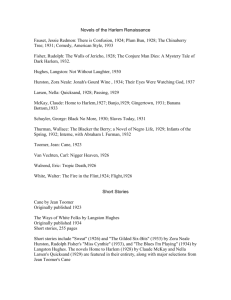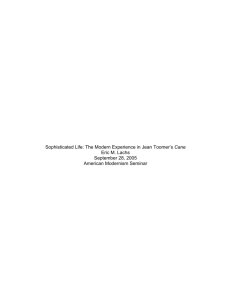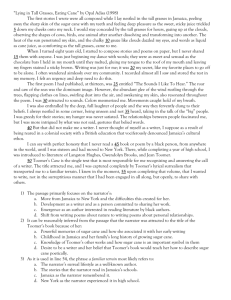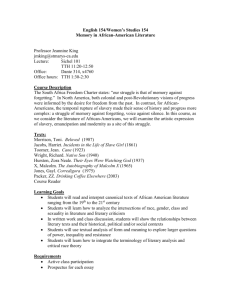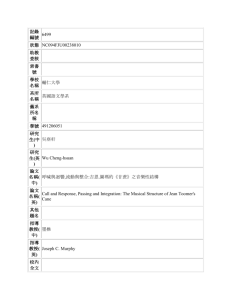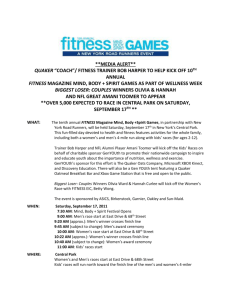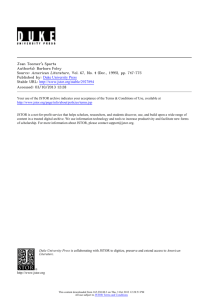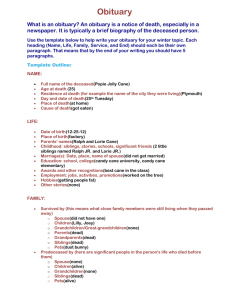Jean Toomer and Cane: “Mixed
advertisement
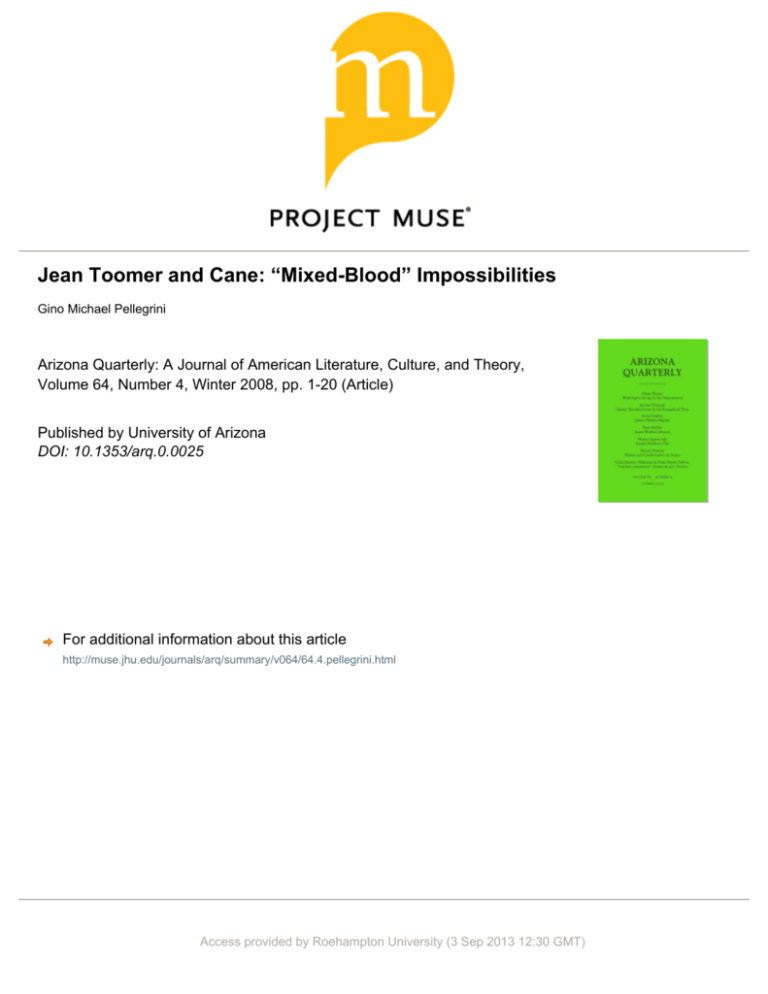
Jean Toomer and Cane: “Mixed-Blood” Impossibilities Gino Michael Pellegrini Arizona Quarterly: A Journal of American Literature, Culture, and Theory, Volume 64, Number 4, Winter 2008, pp. 1-20 (Article) Published by University of Arizona DOI: 10.1353/arq.0.0025 For additional information about this article http://muse.jhu.edu/journals/arq/summary/v064/64.4.pellegrini.html Access provided by Roehampton University (3 Sep 2013 12:30 GMT) gino michael pellegrini Jean Toomer and Cane: “Mixed-Blood” Impossibilities E ven though jean toomer was black and white, his fas- cination with miscegenation in his hybrid short-story cycle Cane (1923) was puzzling and untimely. Joel Williamson writes that by 1915 the one-drop rule had been accepted by both blacks and whites in the North and South (109). Hence, mixed bloods with visible traces of blackness, including members of the former mulatto elite, would be judged as black by both blacks and whites. At best, they could be “in some way, satisfyingly black” (153). In this article, I put forward a reading of Toomer and Cane that explains his fascination with miscegenation in terms of his hope for what was possible in America. Specifically, his unique and solitary position vis-à-vis the New Negro in Black Washington and the Young American in White Manhattan provided him with the reasons, models, and ideals to believe that, in Cane, he could effectively voice and sketch out a mixed race sensibility and community that would be grasped and appreciated by the American public. However, in the process of writing Cane, he came face to face with the rigid categories and limits of the black-white color line in the Jim Crow era, which rendered unintelligible and unsustainable in the culture at large the mixed race sensibility and community he sought to express and develop. In other words, we see in Cane the ultimately futile clash of Toomer’s Young American ideals with the socio-political realities of the black-white color line. Cane reveals the pain and frustration of this clash through muffled and ambivalent narrative voices, and through sketches of unacknowledged, crippled, misunderstood, and lost mixed race protagonists. Arizona Quarterly Volume 64, Number 4, Winter 2008 Copyright © 2008 by Arizona Board of Regents issn 0004-1610 Gino Michael Pellegrini jean toomer between 1918 and 1923: contingency, politics, and the promise of art In their book Jean Toomer and the Terrors of American History, Charles Scruggs and Lee VanDemarr contend that the Toomer who wrote Cane should be read first and foremost as a political writer, although it is true that by end of 1924 he had embraced the spiritual teachings of George Gurdjieff to such an extent that he “could no longer identify with the material that had inspired [Cane]” (Larson 22), and would henceforth eschew black identity. Gurdjieff was an Eastern European mystic of mysterious origin who eventually settled in France. Toomer was so swayed by Gurdjieff’s notion of spiritual wholeness that he actually became his disciple and traveled to France for advanced training (38). This significant turn of events in Toomer’s life has led many critics to read Cane as a kind of spiritual autobiography in which Toomer utilizes modernist form and narrative techniques in an attempt to transcend the polarities of racial categorization and achieve spiritual wholeness. However, critics who read Toomer strictly as a modernist and/or spiritualist tend to overlook connections between Cane and his early political writings. His belief in socialism and support for Negro rights are evident in “Reflections on the Race Riots,” an article about the Washington D.C. race riots of 1919, which Scruggs republished in the Arizona Quarterly alongside Toomer’s other pre-Cane political writings that originally appeared in the socialist newspaper, The New York Call. In this article, Toomer defends the Negroes who rioted in reaction to Washington police brutality. He refers to them as “difficult to exploit,” and attributes “race prejudice” to the “economic structure” and class exploitation. Added to this, he presents socialism both as a means to explain the plight of the Negro and as the one and only political system that can reform a racist nation (Scruggs 121). In 1919, The Nation also published two letters that Toomer wrote to the editor, one regarding socialism and the other regarding Negro rights (Letters 1–3). His decision to voice his socialist and pro-Negro views in print was not without precedent either. He was intimately familiar with the political arena and with the role of being a public representative of the black masses and a defender of their civil rights inasmuch as he was raised by his grandfather, P. B.S. Pinchback, and his wife in their Washington D.C. home. Pinchback, who was also racially mixed but identified as a Jean Toomer & Cane Negro, served as both the lieutenant governor and governor of Louisiana during the era of Reconstruction, and continued to be an influential political figure after moving his family to Washington in 1890 (Larson 169). In 1919, Toomer also associated himself with Alain Locke and his Washington social circle. At the time, Locke was a young professor at Howard University and a leading voice of the emergent New Negro movement. Toomer helped organize a study group with Locke, Georgia Johnson and others in Locke’s circle that focused on historical and sociological aspects of Negro life in America. Toomer spent much of his time outside of Washington after 1921, but maintained a correspondence with Locke and Johnson through 1923 in which he shared much of the material about race, racism, and miscegenation that he had gathered down South in Georgia in preparation for writing the character sketches, poems, and short stories that would eventually compose Cane (268). Toomer would come to view literature and art as the most effective means to uplift the minds of the masses and in so doing create cultural change in America. In New York, he participated in lectures at the radical Rand Institute and attended leftist social gatherings to meet like-minded thinkers and artists. In this way, he met Waldo Frank, who would later become his friend and mentor, give direction and form to the writings that would be included in Cane, and persuade his own publisher, Boni and Liveright, to accept Cane for publication. In 1920, Frank was an affluent and young Jewish intellectual who wrote modernist fiction and cultural criticism. He was also an established writer and well known within the literary and publishing circles of the New York Left. In 1916, he started his own cultural-literary magazine with two other young Jewish intellectuals—James Oppenheim and Paul Rosenfeld. Seven Arts was founded on and sought to promote the following ideals about art and culture: American culture should embrace rather than suppress the cultural histories and artistic expressions of the different American immigrant groups; the artist/writer has the right to reclaim his literary heritage; art and literature can regenerate America (Scruggs and VanDemarr 70). Van Wyck Brooks and Randolph Bourne, who were already established cultural critics joined Seven Arts a short while after its inception. Their scholarship that critiqued the exclusionist ideology and practices of the dominant Anglophile groups in academia and in the American culture at large provided a systematic Gino Michael Pellegrini theoretical framework and program for Seven Arts which, in turn, led to the formation of Young America, a loosely tied literary group that would grow to include writers, artists, and intellectuals such as Sherwood Anderson, Hart Crane, Gorman Munson, Alfred Stieglitz, Georgia O’Keeffe, Lola Ridge, Lewis Mumford, Kenneth Burke, and Jean Toomer (84). Unfortunately, Seven Arts lost its funding and was forced to shut down for publishing Bourne’s articles that criticized the role of the United States in WWI. When Toomer met Frank for the first time in 1920 he had not read his controversial and popular new book, Our America (1919), nor was he familiar with Young America and with the history of Seven Arts. Frank, smarting from the shutting down of Seven Arts, wrote Our America in reaction to the growing tide of nativism, anti-Semitism, and censorship on the Left during and following WWI. He argued for a heterogeneous and hybrid America as a source of strength and promise. He explains in his preface, perhaps to avoid censorship and possible repercussions for his American publishers, that French publishers requested that he write a book that would describe to a French audience the history and cultures of America in relation to “conformist utterance” (Frank ix). Specifically, Our America extends the program of Bourne, Brooks, and Seven Arts in order to critique Anglo-Saxon culture for attempting to “stamp out” from the time of the Puritans onward non Anglo-American cultures and histories. In view of this aim, Frank discusses “buried cultures” such as those of the American Indians and Mexicans and states that Young America is about the discovery of these “adumbrated groups” (10). Furthermore, fusing the political and the literary, Frank contends that the artist/writer has the power to bring into existence a more pluralist, democratic, “trans-national” American culture by creating works that investigate, recover, and record the suppressed histories, utterances, and cultures—the “usable pasts”—of Jews, Italians, Russians, French, Slavs, Germans, and other non-Anglo Americans. As an example, he invokes Walt Whitman as the American writer par excellence who records and celebrates in his poetry the cultures and histories of the different immigrant groups that populated New York at the turn of the twentieth century, “the multitude” that makes up the various “strains” of American culture. For this reason, Frank specifies that for Young America Whitman was far more than the father of free verse, social revolution, and cultural liberation (203). Frank concludes Jean Toomer & Cane Our America with a chapter that presents the New York of his day as the model for a “trans-national” American culture yet to come, and he names and lauds the intellectuals, writers, and artists of Young America, announcing optimistically that their work will “lift America into selfknowledge” (5). The program of Young America that Frank articulates and develops in Our America provided Toomer with the motivation and means to fuse his hybrid racial heritage with his socialist commitment and new literary aspirations. When Frank was attacked by novelist and suffragette Mary Austin in The Nation for promoting the interests of what she saw as the New York Jewish literary establishment in Our America, Toomer—perhaps seeing an opportunity to gain Frank’s confidence— came to his defense by writing “Americans and Mary Austin” in which he explained Frank’s ideas and argued that Austin’s criticisms were based on nativist and anti-Semitic presumptions (Scruggs 122–26). Frank wrote Toomer a thank you letter in October 1920 after reading his article in The New York Call. Toomer wrote him back more than a year later to tell him that what he found lacking in Our America was an account of the American Negro. In his letter, Toomer also described his mixed race background so as to establish his credentials as a Negro, and he included poems and sketches that, in his words, were to be read as “attempts at an artistic record of Negro and mixed-blood America” (Letters 32). Frank responded to Toomer’s writings with genuine enthusiasm. He saw Toomer’s potential as a Negro writer, while he also would have seen him as forerunner of a utopian, hybrid, and “trans-national” America yet to come. That is, Frank saw that Toomer and other “new people,” as Charles Chesnutt called them in The House behind the Cedars (1900), would be possible in the future. In 1922, Frank came to consider Toomer a close friend and a new member of Young America. Toomer was elated about this development: “The euphoria Toomer felt over being associated with Waldo Frank and the group of intellectuals known during the Great War as Young America cannot be overestimated” (Scruggs and VanDemarr 6). Frank provided Toomer with literary identification and legitimacy and connected him directly to Anderson, Crane, Munson, and indirectly to the work of the other writers, artists, and intellectuals of Young America. In addition, through Frank, Toomer gained prime access to the publishers of modernist and leftist literary magazines. In this way, he was able to Gino Michael Pellegrini publish in 1922 and 1923 many of the poems, character sketches, and stories that appeared later in Cane. Toomer would express his gratitude to Frank by dedicating “Kabnis” to him and by asking him to write the introduction to Cane. Moreover, he indicates to the reader that Cane should be read as a contribution to Frank’s Our America project by placing curves before each of its three sections. The curves are emblematic of suppressed cultural “strains” and the hope of a “trans-national” American culture yet to come that would embrace such difference. Cane then would not have been realized without the influence of Frank and the program of Young America. That is, Toomer came to believe after reading Our America that he had the right to investigate and recover his own literary heritage in its entirety; that the cultural and racial difference that he embodied could be an integrating force; and that an artistic record of this suppressed, heterogeneous culture and history (his hybrid ancestry) would be a catalyst for cultural change in America. In light of his appropriation of the ideals of Young America, an attempt “at an artistic record of Negro and mixed-blood America” seemed to his mind at the time both justified and within reach. Hence, in the months that passed from Frank’s thank you letter to his reply, Toomer devised and launched his own project modeled after Our America. In other words, he would start to investigate, recover, and record his hybrid literary heritage. The investigation of his literary heritage, like the sections of Cane, would be divided between the North and the South. For the writings in the Northern section, Toomer drew from his personal experiences and observations. After graduating from high school in Washington, Toomer, at his grandfather’s expense, wandered back and forth from Washington to various Northern cities in search of his calling in life. He studied agriculture for one semester at the University of Wisconsin and another at the Massachusetts College of Agriculture, and in 1916 he studied physical education for a year at the American College of Physical Training in Chicago (Larson 179). In stories and sketches such as “Bona and Paul,” “Avey,” “Theater”, and “Box Seat”, Toomer draws from and reflects upon his personal experiences and observations while living in Chicago, New York, and Washington. Toomer would have to travel down South to investigate that part of his heritage. Georgia was the place of origin for both sides of his family. The opportunity came in 1921 when he agreed to temporarily replace the principal of a Negro school in Sparta, Georgia who Jean Toomer & Cane had to travel up North to raise money for his school. Toomer used his three months in Sparta to investigate the local history of Negro and mixed-blood America and to gather materials for the stories, sketches, and poems that constitute the Southern section of Cane. On one level the final section of Cane, “Kabnis,” is a fictional account of Toomer’s attempt while living in Sparta to investigate, uncover, and record the “mixed-blood” part of his heritage, as well as the social, historical, and economic forces that led to its creation, suppression and displacement to the North. When Toomer finally replied to Frank’s thank you letter he was clear on the purpose of his project, perhaps to the point where he would have continued to write even had Frank responded negatively to his writings. This did not happen. As a result, over the months in which he transformed his materials and writings from 1921 into the highly polished pieces that appear in Cane, he continued to “[draw] upon two different communities of thinking, roughly centered in black Washington and white Manhattan” (Hutchinson 43). Starting with Frank, Toomer attempted to communicate the full scope of his project to members of each community. Unfortunately, both communities claimed Toomer as a Negro and read his writings as predominantly representative of Negro America. In other words, the “mixed-blood America” aspect of his project fell on dead ears. Frank came closest to understanding the full extent of Toomer’s project, probably seeing his fascination with “mixedblood America” in terms of a possible utopian future. Anderson and Crane reveal in their correspondence with Toomer that their understanding of his writings did not extend beyond common stereotypes and assumptions about Negroes and the black experience held by Anglo and European Americans at the time. In general, the Young Americans saw Toomer as a spokesperson for Negro America and a vehicle that could help them gain entry into that world. In view of this shared perception, Frank would ask Toomer to accompany him down South in 1922 and help him pass as black so that he could gather original and authentic material on Negro life and racism for his own planned novel, Holiday (1923). Furthermore, Frank probably peddled Cane to Boni and Liveright as a book about Negro life written by a Negro. In turn, Boni and Liveright marketed Toomer, despite his objections, as a Negro writer and Cane as a book with a “rhythmic beat” comparable to that produced by “the primitive tom-toms of the African jungle” (Soto 172). Gino Michael Pellegrini Unlike the Young Americans, Locke and Johnson were intimately familiar with the complex history of miscegenation in the South. They would have therefore recognized that Toomer was a product of that history, though they might not have fully understood why in 1921 he wanted to investigate and recover his full literary heritage to create “an artistic record of mixed-blood America.” Locke would have understood Toomer’s project in its entirety as unrealistic and politically ineffective. Countee Cullen’s comments about Toomer in a letter that he sent to Locke are generally representative of the manner in which Toomer and Cane were received in Black Washington amongst advocates of New Negro politics. Cullen criticized Toomer for failing in Cane to look “beyond the muck and mire of things” (Cullen qtd. in Scruggs and VanDemarr 219). In other words, the historical record of miscegenation that Cane portrays was not in line with the positive image of the Negro that Cullen, Locke, and other New Negro advocates wanted to present to White America in the 1920s. As a result, New Negro advocates, on the whole, recognized and applauded the positive and unambiguous aspects of Negro life portrayed in Cane, but the social and historical facts, costs, and complexities of miscegenation that Toomer foregrounds, “the muck and mire of things,” had to be ignored at that time for the betterment of the race. This type of selective appropriation of his writings, most notably by Locke in his prominent anthology The New Negro (1925), aggravated Toomer and explains in part why he chose to distance himself from Locke and his other Black Washington friends. That is, even though he was a devout disciple of Gurdjieff by 1925, Toomer still deeply resented individuals and groups of people who limited him and his multifaceted work to the category of Negro. In short, Toomer and his project as a whole were largely misunderstood, especially by the people he thought were closest to him and his work. However, he should not have been surprised or indignant about this outcome since he initially presented himself as a Negro to both White Manhattan and Black Washington. That is, much as his grandfather used his blackness to further his own political career, Toomer, always an opportunist, used his blackness and identified as a Negro to make himself socially and politically recognizable, understandable, and hence publishable. Nevertheless, it was also the case that in 1921 Toomer sincerely believed that, albeit under the influence of the ideals of Young America, he could be both a representative of Negro America Jean Toomer & Cane and, at the same time, be recognized as a spokesperson for the suppressed cultural strain of mixed-blood America. In this way he could investigate and recover his full literary heritage and create a work of literature that when received by the masses would change American culture and help lift Americans into self-knowledge. Toomer, however, would come to realize in medias res that he had been mistaken. In the process of writing and revising the materials for Cane, he reached an impasse with the terrors of American history—the social, historical, political, and material reality of the black-white color line in the Jim Crow era. The ideals of Young America that in 1921 had temporarily allowed him to believe that it was possible for him to sidestep and look beyond this reality did not hold up under the weight of the dictates and limits of the blackwhite color line. In other words, Toomer would come to realize that the buried history of miscegenation in the South had produced a mixedblood America of which he was a part that could not be sustained and was thus destined to dissolve and disappear within the rigid segments of White America and Negro America. He had therefore launched an idealistic investigation into his literary heritage that yielded, and could only have yielded, not answers, resolution, and recognition—“a usable past”—but more questions, uncertainties, silences, denials, and complications. In what was probably a draft of a letter to Frank in late 1923, Toomer remarked how painful the writing process had been for him practically every step of the way. He writes, “In truth, it was born in an agony of internal tightness, conflict, and chaos” (Cane 156). More significantly, one can detect in the diction, narrative voices, characterization, ellipses and lacunas of Cane the impasse that Toomer reached in his project, as well as the feelings of pain, frustration, alienation, uncertainty, constraint, impotence, and dread that accompanied his failure. rendering mixed-blood america: an unusable past and unintelligible present The opening character sketch in Cane, “Karintha,” implies the failure of Toomer’s project, foreshadows the writings that follow, and represents the book as a whole. Karintha, who lives in a small Georgia town, is young, beautiful, and racially mixed with skin “like dusk on the eastern horizon” (3). Men, young and old, and the reader can infer, black and white, have wanted her since she was a little girl. The sympathetic narrator warns, however, that “this interest of the male, who wishes to 10 Gino Michael Pellegrini ripen a growing thing too soon, could mean no good to her” (3). These men assume that her beauty is the source of their sexual desire for her, but Toomer’s diction implies that her beauty is relative to their gaze and to her exotic multiracial somatic features. That is, the narrator stresses that she is perceived as a “thing” or an object. For this reason, “men do not know that the soul of her was a growing thing ripened too soon” (4), and it follows then that they would fail to recognize the visible signs of her pathology when she was a little girl: that she beat her dog, stoned the cows, and fought with other children (3). Even the preacher, so enamored by her physical beauty, excuses her troubling behavior as innocently lovely as a November cotton flower (3). Put another way, the development of her unique human potential, “the soul of her,” is arrested and then redirected in relation to the racialized milieu that surrounds her. This milieu shapes and limits her development from adolescence to womanhood. Her transition into womanhood occurs once she recognizes that she can profit from her value in the community as a desired object or commodity: “they all want to bring her money” (4). The commodification and arrested development of Karintha exemplify how from Toomer’s socialist perspective capitalism sustains the biracial system that both produces and suppresses the cultural strain of mixed blood America and entraps the mixed race protagonists that populate the pages of Cane. A woman now, Karintha decides to abort her mixed race baby. This image of infanticide in the opening pages of Cane is emblematic of the suppression of mixed-blood America and of the failure of Toomer’s own project: “But Karintha is a woman, and she has had a child. A child fell out of her womb onto a bed of pine-needles in the forest. Pine-needles are smooth and sweet. They are elastic to the feet of rabbits . . .” (4). Toomer’s use of ellipsis and antithesis here (“smooth and sweet” contrasted to horrific image of her murdered baby) signals the reader to think critically about the social significance of her act, and perhaps reach the conclusion that her act is as much socially prompted as individually chosen. That is, if she had grown up in a different milieu in a different time, she would not have been impelled to abort her baby. In this milieu, she does not belong to a family or to a community that would have cared that she was pregnant, that would have claimed her and her baby as its own, and that would have noticed her absence. So, she walks out of town nine months pregnant, and she bears and aborts her baby alone, Jean Toomer & Cane 11 its body left abandoned. These images of solitariness and abandonment are representative of a collective mixed race sensibility, yearning, and expression of which Karintha and her baby are a part. Furthermore, next to the pine needles there is a sawmill and a slowly burning sawdust mound, and one can infer that Karintha places the body of her baby there. Weeks after she returns home the smoke from the smoldering sawdust still hovers thick in sky above the valley for people to smell. The body of her baby, literally undetectable in the smoke, is breathed in by the townspeople. The irony here is that the baby would have been socially invisible to the townspeople anyway had it lived, much as they failed to see or understand the “soul” of its mixed race mother. In the biracial social system, the soul of Karintha, her mixed race baby, and Toomer’s project are buried alive before they have a chance to develop, influence others, bear fruit, and bring about cultural change in America. As Monica Michlin notes, Toomer’s text “bleeds out of itself” and “goes down” from its very first page (Michlin 107). The other sketches of mixed race women and men in Cane also reveal how the American biracial system marks multiracial difference, and limits, blocks, and cripples the person who embodies such difference. For instance, much like Karintha, “Fern” and “Esther” are confronted by social-economic situations that prompt them to ripen too soon and develop in ways that are self-detrimental and that limit their potential. Fern finds herself objectified and entrapped by the eyes of others in the Georgia town where she lives. “We walked down the Pike with people on all the porches gaping at us. ‘Doesn’t it make you mad?’ She meant the row of petty gossiping people. She meant the world” (Cane 19). However, the narrator warns that if she were to move up North to Washington, Chicago, or New York she would encounter a similar racialized milieu (“she meant the world”) and thus would probably find herself at risk for being turned into a kept woman or into a prostitute. In reaction to her internalization of the limits and dictates of black-white color line, Fern drops to her knees, her body convulses, and she screams— “Her body was tortured with something it could not let out” (19). In a similar manner, the biracial system blocks and redirects the psychosocial and sexual development of Esther, the mixed race daughter of a grocery store owner in a small Georgia town. As a little girl, Esther thinks that she has fallen in love with King Barlo, a large, physically imposing, dark-skinned Negro who claims divine inspira- 12 Gino Michael Pellegrini tion and passes from town to town in the South to preach and collect money. King Barlo returns to town when Esther is twenty-seven: “Her body is lean and beaten. She rests listlessly against the counter, too weary to sit down” (25). Perhaps driven by the need to alleviate her sense of weariness, solitude, and desperation, which are effects of the raciated climate that surrounds her, she decides that she must confront King Barlo and tell him how she feels. She finds him late at night in a house in the black part of town—there seems to be a party, she walks up the stairs, Barlow is drunk, and black men and women are gathered all around. He refers to her as a “lil milk-white gal,” tells her “this aint th place fer y,” and wants to know what she wants (27). Black women standing about the room laugh at her and shoo her away once they realize what she wants. She feels replused; he is not at all like she imagined him: “She draws away, frozen. Like a somnambulist she wheels around and walks stiffly to the stairs. Down them. Jeers and hoots pelter bluntly upon her back. She steps out. There is no air, no street, and the town has completely disappeared” (27). The sketch ends with her outside of the house and alone. This conclusion reveals and confirms the solitary and marginal social position that she occupies. She belongs to neither the black or white community, and like Fern there is no place for her to go. “Avey” grows up in Washington an orphan and racially mixed, and much like Karintha, men, young and old, have wanted her since she was a little girl. The narrator grew up with Avey in the same neighborhood and has always been enamored of her. A grown man, he returns home to Washington and looks for her. He sees her one evening walking along U Street with a male companion. She appears to be living the life of a kept woman. She wears expensive clothing, but looks worn out, listless, and somnolent. The narrator asks Avey to walk with him to Soldier’s Home, the park where he goes to be alone with the soul of another. There he explains to her that “her emotions had overflowed into paths that dissipated them” because the “proper channels” for such emotions do not exist in society (48). He knows her situation, suppression, and depression because they are also his own. In other words, the narrator sees that the dictates and limits of the black-white color line have stymied the development of the soul and potential inside of her. He also thinks that he has a remedy for her situation. He believes that art, his art, will change her situation as well as the culture of black- Jean Toomer & Cane 13 white color line: “I talked beautifully I thought, about an art that would be born, an art that would open the way for women the likes of her. I asked her to hope, and build up an inner life against the coming of that day” (48). This passage communicates the aim of Toomer and of the other members of Young America to uplift the minds of the masses with their art/literature and thereby effect cultural change in America. Unfortunately, Avey has fallen asleep and does not hear the narrator talk: “Then I looked at Avey. Her heavy eyes were closed. Her breathing was as faint and regular as a child’s in slumber. My passion died” (48). This pessimistic conclusion implies that Avey’s arrested psychosocial development and her precarious and marginal position in society are unchangeable. This conclusion also implies that the rigid segments of the black-white color line have effectively blocked the communication channel between Toomer’s intended audience and the purpose of his project. Hence, both the narrator’s art and Toomer’s project will in all probability fall short of being born. The narrator of “Avey” and the other mixed race male narrative voices in Cane must navigate the same rigid segments of blackwhite color line that limit and damage the mixed race women whom they describe. For this reason, these narrative voices, on the whole, are sympathetic, but also hesitant, ambivalent, and conflicted about their own social standing. They also shift in and out grammatically from first to third person, and they are continually on the move from place to place. Hence, the narrative voices in Cane might be thought of as trying to stave off the blocks, dictates, and categories of a society structured through the black-white color line long enough for an art to be born—theirs and Toomer’s—that will change American culture and thereby liberate them and women like Avey, Esther, and Fern. The aim of their art is to recover through a meticulous piecing together of words, phrases, and lyrical rhythms the sensibility, yearnings, and embodied difference of the mixed race women and men they portray, whose “souls” and potentialities have been stamped out and re-channeled in and through the biracial system in the service of the dominant Anglophile culture. At the same time, these narrative voices, cognizant of their own uncertain and marginal status within the biracial system, portray their mixed race subjects as powerless to circumvent the dictates and limits that the biracial system thrusts upon them. Caught in this dilemma between the aim of their art and the historical-material 14 Gino Michael Pellegrini reality of their situation, the male narrative voices of Cane—perhaps unintentionally on Toomer’s part—also reveal and express their own feeling of dread and impotence. Further, these narrative voices reveal themselves as powerless to change situations in which they are both participants and witnesses. This is clearly the case in “Becky”; “Becky was the white woman who had two Negro sons. She’s dead; they’ve gone away. The pines whisper to Jesus. The Bible flaps its leaves with an aimless rustle on her mound” (7). The narrator sympathizes with her situation while he is also complicit in her exclusion from the southern town in which she lives. That is, while he laments her situation he is, at the same time, in accord with the tacit agreement that the townspeople reach to build a cabin for her and her mixed race children in a small strip of land on the outskirts of town between the railroad track and the main road. However, the cabin collapses one day: “Through the dust we saw the bricks in a mound upon the floor. Becky, if she was there, lay under them. I thought I heard a groan. Barlo, mumbling something, threw his bible on the pile. (No one has ever touched it.) Somehow we got away. My buggy was still on the road” (9). The narrator who is passing by on the road with another townsman is there to witness the fallen structure and hear Becky moan under the rubble, but he does nothing to help and then runs away from the situation. Toomer’s use of parenthesis here again reveals the narrator’s complicity. In a like manner, the narrator of “Fern” boards the train and heads back North after he walks with her through the canebrake and there ascertains the severity of her situation as well as his own inability to do anything about it. Similarly, the narrator of “Avey,” having failed to communicate his art and his message to her, will likely take flight again from Washington. In other words, the male narrative voices in Cane are inclined to flee once they realize that they are caught in the middle of situations that surpass their understanding and ability to intervene and effect change. This inclination is also evidenced in the character Dan Moore in “Box Seat” who at the end bolts out of a Washington theater into a black alley and “keeps going on” (69), as well as in the character Lewis in “Kabnis” who runs out of Halsey’s basement once the horror of the situation becomes too painful and intense for his systematic intellect to bear. On the other hand, the mixed race character Paul in “Bona and Paul” does not flee from the complex situation that confronts him in Jean Toomer & Cane 15 Chicago. Instead, he attempts to understand in a philosophical manner his differentiation and marginalization vis-à-vis the American biracial system. Paul, much as Toomer did in 1916, studies physical education at a college in Chicago. Bona is a white female student who attends the same college. She thinks that she is in love with him after she sees him playing basketball in the gymnasium. Paul, however, suspects that Bona is merely fascinated by his racial difference. An attractive mixed race male, his interaction with Bona parallels the experiences of Avey, Karintha, Fern, and the other mixed race women in Cane who are objectified, marked, limited, and damaged by the normative black-white social gaze. Paul, however, is only vaguely aware of how the biracial system conditions Bona and others to see him as racially different and then prompts them to be fascinated by that difference. He explains to Bona (who accuses him of having “grown cold” and being a “philosopher”) that he knows “mostly a priori” that “mental concepts rule” her and that she does not love him (79). Mental concepts and knowledge that are a priori exist prior to individual experience, but what Paul means here by a priori are the categories, mechanisms, and dictates of a racist culture that a priori mark, limit, and differentiate him and others. Paul comes to an initial and partial understanding of this unconscious, cultural process of racialization through the repetition of painful experiences with women like Bona and in places such as Crimson Gardens. The Crimson Gardens is a segregated club in Chicago where Bona, Paul, his roommate Art, and his girlfriend, Helen, go on a double date to drink and dance. There amidst a barrage of stares from onlookers in the club: A strange thing happened to Paul. Suddenly he knew that he was apart from the people around him. Apart from the pain which they had unconsciously caused. Suddenly he knew that people saw, not attractiveness in his skin but difference. Their stares, giving him to himself, filled something long empty within him, and were like green blades sprouting in his consciousness. There was a fullness, and strength and peace about it all. He saw himself, cloudy, but real. (77) Paul’s realization, however, is not a remedy for his situation and will not help him transcend the material and ideological bounds of a racist 16 Gino Michael Pellegrini nation. Transcendence here might be possible if he had been born and raised outside the American social system like his Norwegian roommate, Art. Paul loves Art (75), and Art truly does not care, as rumor has it, that Paul might be part black. Art, who is a jazz playing “carboncharged” “purple fluid” (75), also represents the art and the ideals of Young America and the hope of a “trans-national” American culture yet to be born. Art, however, (and this might also be read as indicative of Young America) finds himself when push comes to shove angered yet powerless to do anything about the stares and the general racist climate that surrounds Paul in the college and at the Crimson Gardens. Paul though seems to have come to terms with his situation on his own; he is for the moment comfortable in his skin and wants to be with Bona. Ecstatic, he walks back into the Crimson Gardens to shake hands with the black doorman, but when he reemerges back onto the street Bona is gone and so is Art (80). This conclusion implies that if Paul has indeed come to terms with the stares and his mixed racial background and perhaps chanced upon the beginnings of a mixed race identity as Naomi Zack suggests (136), then his was deeply subjective and solitary experience, understood by him at that moment and not communicable to a broader audience. In other words, the conclusion confirms the marginal and solitary social position that he occupies. Bona and Art (the art and ideals of Young America) have abandoned him, and he thus finds himself alone in the street at night staring back in the distance at the lights of the Crimson Gardens. a representation of toomer’s failure The final piece in Cane, “Kabnis,” affirms the power of the biracial system in the Jim Crow era to effectively suppress and block sensitive and intelligent mixed race individuals such as Paul and Toomer who struggle to understand, resist, and surpass the limits that their situation imposes on them. “Kabnis” depicts the everyday lived existences of different mixed race individuals in Sempter, a town in Georgia that is thoroughly divided by the black-white color line. “Kabnis” is also an allegory of Toomer’s trip to Sparta, Georgia and his attempt to investigate, uncover, and reclaim his literary heritage. Here the reader should not underestimate the significance of Toomer’s assertion to Frank that “Kabnis is me” (Letters 116). Toomer makes use of the psychological theme of the double, a common feature in the work of turn-of-the cen- Jean Toomer & Cane 17 tury modernist writers such as Joseph Conrad. Lewis and Kabnis are doubles: “Lewis is what a stronger Kabnis might have been, and in an odd faint way resembles him” (Cane 97). Hence, if Kabnis is Toomer, then Toomer is Lewis. Accordingly, Lewis and Kabnis are both racially mixed northerners who find themselves in the South for similar reasons that mirror Toomer’s own. Kabnis, whose family was originally from “Georgia” (89), is in search of his southern roots and a stable identity. He is “uprooted, thinning out. Suspended a few feet above the soil whose touch would resurrect him” (98). In a manner that parallels Toomer’s own investigation in Sparta, Lewis walks about town and talks to the townspeople to uncover the buried history of miscegenation and to record the everyday lived realities of mixed race people such as Halsey and his family. Halsey, who runs his own metal and wood shop, is of all the mixed race characters in “Kabnis” the most adept at coping with the situation and his mixed-blood heritage. In addition, much as Sparta residents typically answered Toomer’s questions with silence, denials, and warnings, the line of questioning that Lewis takes annoys the white community and provokes violent threats from anonymous members of the Negro community. In the Jim Crow era, the townspeople of Sempter, like the townspeople of Sparta, are content to live their lives and conduct their business in accordance with the one-drop ideology of the biracial system. Hence, an outsider from the North who tries to stir up “the muck and mire of things” would not be received kindly. The climatic scene in “Kabnis,” the night of drunken debauchery in the cellar below Halsey’s workshop, reveals the impasse that Toomer himself reached with the terrors of American history. Halsey’s basement, “the Hole” (105), has served the downtrodden and solitary mixed race people of Sempter for many years as a nighttime gathering place in which they wallow in their own abjectness and ease their collective pain with alcohol and sex. Halsey invites Lewis to participate this particular night. Kabnis, Cora, and Stella descend into the Hole with them. In addition, the blind and mute former slave Father John is always present in the Hole to oversee each depraved bacchanal. Having lived through the Emancipation and the Reconstruction, he represents the buried history of miscegenation in the South; he stands as a symbol for the collective sin and denial of miscegenation. The descent into the Hole also signifies a descent into the human psyche, that of Toomer and that of the mixed-blood collective he repre- 18 Gino Michael Pellegrini sents. As Scruggs and VanDemarr note, here Toomer draws on the tradition of gothic literature to create the imagery and texture of the Hole; he also draws on the detective novel genre to construe the role that Lewis plays (195). In the Hole, Lewis is the detective who believes that his systematic reasoning will yield facts and a final resolution. Lewis is also a manifestation of the calculating and analytical side of Toomer’s mind. Kabnis, on the other hand, is a projection of Toomer’s sensitive and artistic side. Hence, Kabnis thinks of himself as an “orator” full of “misshapen, split-gut, tortured, twisted words” (Cane 111) that he wants to express eloquently and poetically to a broad audience. Indicative of Toomer’s own internal conflict while composing Cane, Kabnis envies Lewis for his personal qualities, while Lewis seems repulsed by the weakness, insecurity, and sense of self-defeat that he detects in Kabnis’ words and mannerisms. Lewis deduces that Kabnis lacks not only a stable identity but also a sense of belonging and a purpose in life. The name “Kabnis” itself which sounds awkward and does not quite fall in line with the grammar of first and last names in American English implies that his existence is socially unintelligible, that his lived reality does not make sense in a black and white social universe. For that reason, Halsey tells Lewis that he has taken Kabnis under his wings to give him a trade and make a man out of him. In the Hole, Kabnis defends himself against Lewis and Halsey who criticize and ridicule him, but his defiance is short-lived as he surrenders himself to the situation: “Kabnis mutters. Tries to break loose. Curses. Cora almost stifles him. He goes limp and gives up” (112). At almost the same instant that Kabnis gives up, Lewis finds himself face to face with the terrors of American history, an entangled and complex mess of pathos, cruelty, and ambiguity that plays out in front him in the Hole: “Kabnis, Carrie, Stella, Halsey, Cora, the old man, the cellar, and the work-shop, the southern town descended upon him. Their pain is too intense. He cannot stand it. He bolts from the table. Leaps up the stairs. Plunges through the work-shop and out into the night” (112). The complexity and intensity of the situation overwhelm Lewis’s orderly mind. One can infer that Lewis both flees from this situation and, much as Toomer did in Sparta, boards a train headed back North devoid of any desire to ever go back. As Toomer declares to Frank, Cane was his “swan song” because “never again” did he “want a repetition of those conditions...which produced Cane” (156). For this reason, Toomer and Lewis Jean Toomer & Cane 19 are content to abandon Kabnis (that part of them) in the cellar where he will continue to flounder in his pathos and uncertainty. Lewis, however, has also suffered a crushing defeat in that he falls miserably short of achieving the purpose of his investigation. It is in this context, that is, in the aftermath of Lewis’ failure to untangle the complex situation before him and Kabnis’ failure to express this situation poetically to a broad and receptive audience that we can begin to understand Toomer’s sudden conversion to Gurdjieffism and his rejection of racial identity. In other words, we might understand Toomer’s sudden conversion to Gurdjieffism as a reaction to his failure to effectively present and communicate the complexities and lived realities, the “suppressed cultural strain” of mixed-blood America through the character sketches, poems, and stories in Cane. Through the reception of his work in the publishing industry, in Black Washington, and in White Manhattan, he came to realize that an immense and unbridgeable communication gap existed between the purpose of his project and his intended audience. In light of this painful and frustrating realization, and because his political aspirations had always been stronger than his literary ones, he chose to make Cane his swan song. One should not forget here that his literary efforts were borne out of his socialist conviction to influence the masses and change America for the better through both personal and collective action. Hence, his conversion to Gurdjieffism might be read as a decision based on political expediency. Staying close to the conditions that produced Cane, as Sherwood Anderson suggested to him, to create more pieces like the ones in Cane, would not only have been personally painful and frustrating but would have been politically ineffective and inept. In other words, Toomer arrived at the realization that the “artistic record” of his own hybrid literary heritage would influence no audience let alone lift America into self-knowledge. On the other hand, in Gurdjieffism he thought he had found a doctrine through which he could effectively influence the minds of the masses and thereby create positive change in the American social order. That he was wrong on this account should not diminish our view of him as a political writer and of Cane as one of the finest works in American Literature. Pierce College 20 Gino Michael Pellegrini works cited Chesnutt, Charles W. The House behind the Cedars. 1900. New York: Penguin, 1993. Frank, Waldo. Our America. New York: Boni and Liveright, 1919. Hutchinson, George. “Identity in Motion: Placing Cane.” Smith and Feith 38–56. Larson, Charles. Invisible Darkness. Iowa City: Iowa University Press, 1993. Locke, Alain. The New Negro. New York: Boni and Liveright, 1925. Michlin, Monica. “Karintha: A Textual Analysis.” Smith and Feith 96–108. Scruggs, Charles. “‘My Chosen World’: Jean Toomer’s Articles in The New York Call.” Arizona Quarterly 52.2 (1995): 103–26. ——— and Lee Vandemarr. Jean Toomer and the Terrors of American History. Philadelphia: Penn University Press, 1998. Smith, Genevieve, and Michael Feith, eds. Jean Toomer and the Harlem Renaissance. New Jersey: Rutgers University Press, 2001. Soto, Michael. “Jean Toomer and Horace Liveright; or, A New Negro Gets ‘into the swing of it.’” Smith and Feith 162–87. Toomer, Jean. Cane. 1923. Ed. Darwin T. Turner. New York: Norton, 1988. ———.The Letters of Jean Toomer. Ed. Mark Whalan. Knoxville: The University of Tennessee Press, 2006. Williamson, Joel. New People: Miscegenation and Mulattoes in the United States. 1980. Baton Rouge: Louisiana State University Press, 1995. Zack, Naomi. Race and Mixed Race. Philadelphia: Temple University Press, 1993.
